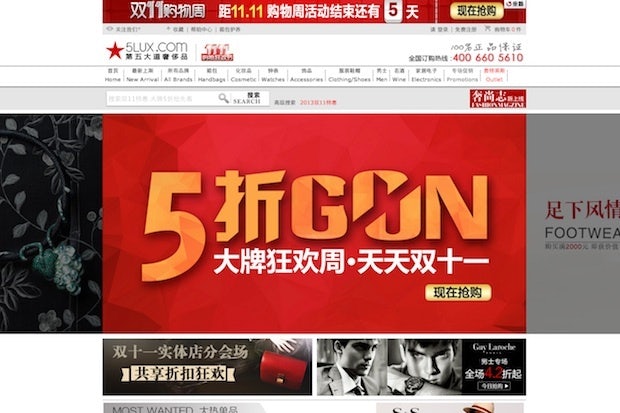
A Singles' Day promotion for online luxury retailer 5Lux. (5Lux)
China’s e-tail bonanza Singles’ Day, or "11/11", demonstrated the stunning growth of China’s e-commerce market with its enormous $5.7 billion in sales on Tmall alone this year. With total online sales for the country set to rise to about $296 billion by the end of this year, learning the keys to success in China's online marketplace is vitally important for brand success.
Luxury is set to take up a significant part of the online retail pie, with an estimation to be worth $27 billion by the end of this year. However, China's e-tail landscape has proven especially tricky for luxury brands. Despite the significant profits to be made, Macy’s put its China e-commerce plans on hold in October of this year, which followed a decision by Neiman Marcus to downscale its China e-commerce operations several months ago.
These instances likely reflect the fact that luxury e-commerce faces many challenges in China, including logistical issues that harm quality of service, customer concerns about fakes, and fear of online fraud. However, the business climate may be improving: a recent survey of Chinese luxury customers by Ruder Finn and IPSOS found that 36 percent of respondents prefer to shop for luxury goods online, a 22 percent increase from 2012.
In order to respond to challenges in the market, there are several issues brands can focus on. While there may not be a magic cure to the most common online luxury retail obstacles, the numbers prove that companies that succeed have major profits in store. Look below for five major areas where efforts can be directed in the mainland luxury e-commerce market.
Offer strong after-sales service#
According to the Ruder Finn/IPSOS survey, an overwhelming majority of respondents from mainland China (81 percent) said that after-sales service was their number one demand for online shopping. This response may betray a current lack of quality e-tail service on the mainland, as 88 percent of Hong Kong respondents, in contrast, stated that web layout and browsing ease were most important.
Take steps to curb any dissatisfaction#
The two next most significant factors for mainland online luxury consumers were ease of return and exchange (43 percent) and efficient response to problems (30 percent). Compared to the next-highest results for Hong Kong—clear search categories and easy-to-use search box—it becomes even more obvious that some luxury e-tailers on the mainland are not performing up to par in making customers feel that their concerns are being resolved. A quality website layout can't help bring customers back if they feel they were unfairly treated on the last transaction.
Guarantee authenticity#
The survey conveyed good news about concerns over rampant online fakes in China: 60 percent of mainland Chinese consumers questioned indicated more confidence in purchasing authentic items online this year. However, fakes are still a major problem, and even major luxury e-tailers have proven susceptible to complaints. This issue is most important for multi-brand retailers as opposed to official brand sites, where it's much easier to let customers know they're getting the real thing.
Easy payment options#
Low credit penetration and concerns about credit fraud are being assuaged by brands by offering other options for payment, including Alipay, cash on delivery, or allowing customers to pay through their banks. For Singles’ Day, luxury e-tailer 5Lux highlighted this latter service by teaming up with the four main national banks of China (Bank of China, Agricultural Bank of China, Industrial and Commercial Bank of China, and China Construction Bank) to offer customers a special discount and the chance to be entered in a drawing for a cash prize if they paid using their bank account.
Don't discount social media#
Social media is often considered to be a way to merely convey brand heritage and help fans connect with the brand as opposed to a direct driver of e-commerce. However, 52 percent of mainland respondents to the survey said that word-of-mouth is the most important factor in establishing trust toward an online luxury retailer. As a result, social media promotions calling on users to recommend brand posts to friends may have more of an impact than expected. In addition, brands have been experimenting with ways to use social media as an e-commerce driver: for example, for Singles’ Day, Clarins ran a promotion on Sina Weibo that coincided with an offer to match shoppers’ purchase amount with free gifts, while Coach regularly uses its Sina Weibo account to feature photos of celebrities wearing its products along with a link to purchase said product online.